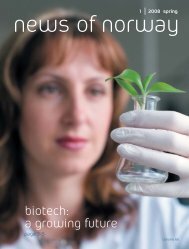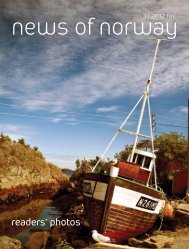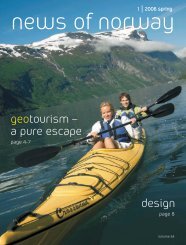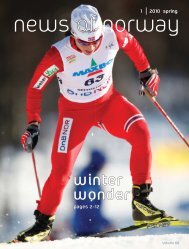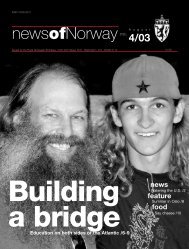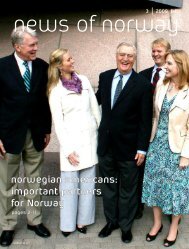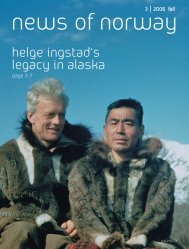henrik ibsen
henrik ibsen
henrik ibsen
- No tags were found...
Create successful ePaper yourself
Turn your PDF publications into a flip-book with our unique Google optimized e-Paper software.
THE LIFE OF IBSEN1828 Henrik Johan Ibsen born on March20th in Stockmannsgården in Skien.Parents: Marichen (née Altenburg) andKnud Ibsen, merchant.1835 Father has to give up his business. Theproperties are auctioned off. The familymoves to Venstøp, a farm in Gjerpen.Love'sReconciliation:On the Contemporary Significance of Ibsen’s Ethics1843 Confirmed in Gjerpen Church.Family moves to Snipetorp in Skien.Ibsen leaves home on December 27th.1844 Arrives in Grimstad on January 3rd tobe an apprentice to chemist Jens AarupReimann.1846 Has an illegitimate child with ElseSophie Jensdatter, Reimann’s servant.1849 Ibsen writes Catiline.1850 Goes to Christiania to study for theuniversity entrance examination.Catiline is published under the pseudonymBrynjolf Bjarme. Is editor of the Students’Union paper Samfundsbladet and the satiricalweekly Andhrimner.First Ibsen staging in history: the one-actThe Burial Mound is performed atChristiania Theater on September 26.1852 Moves to Bergen to begin directingproductions at Det norske Theater.Study tour to Copenhagen and Dresden.1853 First performance of St. John’s Night.1855 First performance of Lady Inger.1857 First performance of Olaf Liljekrans. Isappointed artistic director at KristianiaNorske Theater.1858 Marries Suzannah ThoresenFirst performance of The Vikings atHelgeland.1859 His son Sigurd is born.1861 Writes the poem Terje Vigen.1862 Kristiania Norske Theater goes bankrupt.Ibsen goes to the valley ofGudbrandsdalen to study folklore.Love’s Comedy is published (first performanceat Christiania Theater on November24th 1873).1864 The Pretenders is performed atChristiania Theater. Leaves for Italy andlives in Rome for four years.1866 Brand is published and is a success.Ibsen is awarded a state stipend for artists.6 | news of norway | 2 | 2006BY NATHAN HOPKINSIn the late 19th century, Henrik Ibsen’splays passionately raised insightful questionsabout the individual’s place withinsociety that incited an honest and critical selfreflectionin audiences. For this and manyother good reasons, Ibsen long ago joined thelikes of Shakespeare and Arthur Miller on thelist of Great-Western-Dramatists. Thankfully,though some facets of his work do show theirfair share of age, Ibsen has survived theentombment that often goes hand-in-hand withcanonization and now, one hundred years later,we have only begun to realize just how complicatedand poignant Ibsen’s questions really are.We have inherited a tradition of radicalfreedom and individuality, one with whichIbsen was very familiar and to which he wassomewhat sympathetic. Take the slamming ofthe door at the close of A Doll’s House; this hasbecome a paradigmatic symbol for self-determiningfreedom and choice. Nora has realizedthat she has never actually chosen anything inher life but has only been a passive commodity,passed from one man to another. She tellsTorvald, “I have to stand completely alone, ifI'm ever going to discover myself and theworld out there.” Before Nora can ever be aparent or a wife, she must first be herself. InIbsen’s oeuvre, this ideal of authenticity, freeself-discovery, often appears as the foundationfor all other ethical commitments.Though we in the liberal democratic Westcan’t help but feel inspired by this message,our culture has already traveled the length ofthis road and has discovered where it leads.Totally untempered, ideas like radical freedom,individualism, and authenticity eventuallyarrive at solipsism and nothingness. Jean-PaulSartre’s concept of the self as “a hole in theheart of Being,” or Erving Goffman’s morepostmodern comparison of the self to ”a peg”on which the costume of a social role is hung,are both foremost examples of this. These selfcenteredconcepts have also spearheaded theerosion of ethics into today’s problematic relativism,where debates are irreconcilable andpower is the only viable currency.In The Ethics of Authenticity, published in1991, Charles Taylor wrote, “…I can definemy identity only against the background ofthings that matter. But to bracket out history,nature, society, the demands of solidarity,everything but what I find in myself, would beto eliminate all candidates for what matters.”Our culture is finally beginning to pull back thereigns on radical individualism and recall theimportance of tradition, commitment, andcommunity. But the warnings of ethicists likeCharles Taylor or Alasdair MacIntyre are thesame warnings that Ibsen counseled over onehundred years ago. Almost prophetically, Ibsenforesaw the unsavory consequences of the liberalideals that he called “crumbs from the revolutionarytable of the last century.” No otherplay states Ibsen’s ethical warnings as clearlyas Peer Gynt.Peer’s egoism, his confidence in his “essentialself,” keeps him from earnest interactionwith the external world-friends, family, ideologies,nations, etc. Thus Peer becomes a fracturedpersonality, an aesthete without responsibility,without passion, without commitment,and therefore without meaning; not even worthyof hell, he is to be thrown on the scrapheap. Though this may seem like an internalpsychological issue rather than an external ethicaldilemma, remember that the thing whichsaves Peer from the Button Moulder’s ladle isSolveigh, the commitment that he abandoned,but which never abandoned him. When Peerposes his existential query, “Where was I?Myself-complete and whole? / Where? WithGod’s seal upon my brow?” it is Solveigh’sanswer, “In my faith, in my hope, and in mylove,” that saves him from the ladle.For Nora, authenticity is found in the selfassertingact of leaving her family; for Peer,authenticity is discovered in the “self-slaying”act of returning to family. While Ibsen at timesadmonishes the individualistic progressive valuesof his time, he just as often condemns themand all other aureate idealisms. Seen this way,Ibsen himself may appear to have a rather frag-
<strong>ibsen</strong>mented understanding of identity and interpersonal-relations.However, an additional elementis present which accounts for and reconcilesthese discrepancies; it is the foundationalelement of Ibsen’s ethics which Nora called“the greatest miracle of all” – that is, of course,love.The absence of Ibsen’s “transformative”love is what drives Nora to leave, but its presenceis what forces Peer’s return. Love reconcilesthe internal and the external, individualityand commitment, narcissism and self-loathing:all these seemingly opposing poles in bothIbsen’s plays and our contemporary moral situation.Love implies an earnest, passionate, andmostimportantly-reciprocal commitment toanother person while concurrently requiringmutual respect for the other’s unique individualityand individual freedom. Therefore, inIbsen’s plays and, I propose, in actual existence,love is the only relationship in whichSt. Olaf College student Nathan Hopkins won theHenrik Ibsen essay contest sponsored by theNorwegian Researchers and Teachers Associationof North America (NORTANA). The prize includesa round-trip ticket to Norway and two nights accommodationfrom the organization NorwegianLiterature Abroad (NORLA)Hopkins, a philosophy major, became interestedin learning more about Ibsen after listening to TorilMoi, a recent guest lecturer at St. Olaf. Hopkinsenjoyed her philosophical take on Ibsen and readIbsen voraciously over the next month, composingthis essay in a fit of inspiration. “I think that Ibsen –like Dostoevsky or Camus – is as much a philosopheras an author, which appeals to me,” he said.one can be truly just-in which one can authenticallybe oneself and allow the other to dolikewise, without becoming trapped in resignment,solipsism, or nothingness. Of course,Ibsen’s authorship abounds with examples ofwhere this all goes wrong, but it is probablybest to look at the optimistic exception, TheLady from the Sea, to see what it looks likewhen it all goes right.The Lady From the Sea bears a strikingresemblance to A Doll’s House in all but itsending. Like Nora, Ellida feels trapped in abourgeois marriage that she doesn’t consider tobe ”true.” She is estranged from her stepchildrenand removed from the environment inwhich she feels comfortable. Worst of all,Ellida says that she didn’t come to this home ofher own free will, and “in that phrase,” she tellsher husband, “lies everything.” As she sees it,her only way to freedom is to “cancel the bargain”with Wangel and confront the demonsfrom her past.Although Wangel comes to understand thathe “never really knew” his own wife, he stillfeels it is his duty to “protect” Ellida from herown freedom. At the close of act four, Wangelbears foreboding resemblance to Torvald: hecannot truly love Ellida because he cannot takethe miraculous and transformative leap,because he will not grant her freedom, for fearof losing her completely. At this point, it seemsas if Wangel wants, in Sartrean terms, “to beloved by a freedom but demands that this freedomas freedom should no longer be free.”Thankfully, towards the very end of actfive, when The Stranger has arrived and thechoice can no longer be avoided, Wangel realizesthe contradiction of his desire. Though hemay be able to physically detain his wife, heknows that he can never imprison her thoughtsor dreams, and in order to keep driving theseeven farther away, he must allow Ellida tochoose for herself. In this miraculous momentof emancipation, the relationship betweenEllida and Wangel is instantaneously transformedinto a true and loving marriage. Ellidais allowed the freedom that makes authenticethical decision possible. She no longer has toleave her husband in order to become herself,because she, unlike Nora, can be herself withinthe now-true marriage.The issue of responsibility is equallypresent in this moment. Wangel tellsEllida, “Now you can choose-free-onyour own responsibility.” She then saysto herself, “Responsibility as well? Butthat changes it all.” Ellida realizes that tochoose The Stranger, “the unknown,”would be to choose freedom for freedom’ssake, which, recalling the earlierCharles Taylor quote, eliminates all possiblecandidates for meaning. Ellida isnow in a true marriage, a loving relationshipwith Wangel–this is her candidatefor meaning and she can now authenticallybind herself to it.Here is Ibsen’s understanding of ideallove: the lover does not seek to imprisonthe beloved in body or in soul, butinstead, with full knowledge of the risk,the lover allows the beloved the freedomrequired for her to authentically love him inreturn. Thus the relationship is a reciprocalaffirmation of the other’s freedom rather than acontradictory and one-sided negation of it.Love is the only situation in which every partyis totally free and still within a horizon ofmeaning, thus it is the only relationship inwhich each party can maintain meaningfulresponsibilities and, therefore, it is the onlyviable foundation for a truly compulsory ethic.Ibsen’s understanding of ethics is not systematicand abstract, but deeply personal. Heacknowledges the subjectivity and freedom ofthe ethical agent but knows that his or her decisionsare only meaningful if they involveearnest interaction with another person, specificallythe beloved. Most importantly, Ibsen’sethic maintains a solid ought–a sense ofresponsibility that, though personal, is stillforcefully binding. These insights are, I think,original and important contributions to currentmoral debate. Ibsen’s ethic fuses the understandingof tradition one finds in contemporaryVirtue Ethics with the authenticity ofExistentialism; the latter keeps the whole fromfalling into solipsistic relativism and the formerguards against reduction to postmodernrole-playing.1867 Writes and publishes Peer Gynt (firstperformance at Christiania Theater onFebruary 24th 1876).1868 Moves to Germany for seven years.1869 The League of Youth is published.Ibsen goes to Egypt and is present at theopening of the Suez Canal.1871 Publishes a collection of poems (Digte)for the first and last time.1873 Completes Emperor and Galilean.1877 Pillars of Society written and firststaged at Det Kongelige (Royal) Teater inCopenhagen. Awarded an honorary doctorateat the University of Uppsala.1878 Moves to Rome again and stays therefor seven years except for several breaks.1879 Writes A Doll’s House1881 Writes Ghosts (staged at the AuroraTurner Hall in Chicago on May 20th 1882).1882 Writes An Enemy of the People.1884 Writes The Wild Duck.1886 Writes Rosmersholm.1888 Writes and publishes The Lady fromthe Sea (first performed at Hoftheater inWeimar and at Christiania Theater on thesame day, February 12th 1889).1889 Last summer in Gossensass, Germany.Gets to know Emilie Bardach.1890 Writes and publishes Hedda Gabler(first performed at the Residenztheater inMunich on January 31st 1891).1891 Returns to Norway and settles inChristiania. Meets Hildur Andersen.1892 Writes The Master Builder. SigurdIbsen marries Bergliot Bjørnson.1894 Writes and publishes Little Eyolf (firststaged at the Deutsches Theater in Berlin)1895 Moves into apartment on the corner ofArbiensgate and Drammensveien inKristiania where he lives for the rest of hislife.1896 Writes John Gabriel Borkman.1898 70th birthday – large-scale celebrationsin Kristiania, Copenhagen and Stockholm.1899 Writes When We Dead Awaken.1900 Suffers his first stroke.1906 Dies on May 23rd.www.norway.org/<strong>ibsen</strong> |7
travelHome of Peer GyntBY ARILD STRØMMENAtraditional long-table in a farm-house at Vinstra in Norway hasbeen set with the farm’s own cutlery, fresh meat of moose,smoked salmon, and home-made sour cream. The aroma offreshly brewed coffee seeps out from the kitchen, where 24-year-oldchef Tor Kramperud is in the finishing stages of tonight’s dinner. MikkelDobloug, owner of the farm named Per Gynt Gaarden, retreats to hisdesk in the library. 4,870 books line the walls. An old polar bearskin adorns the floor. (see photo on opposite page)On the wall hangs a portrait of Mikkel Dobloug’sgreat-great-grandfather. The house is filled with antiquities,paintings, and remnants of a bygone era. But not asingle television. Cell phones are not allowed. The mostmodern object in sight is a pair of antique binocularsthat rest on the windowsill. Looking through it out thewindow you can see the mountains and the sun about togo down behind the dense Norwegian forest. It doesn’ttake much to understand that this is a special place: In fact,this is where the person who was the inspiration for HenrikIbsen’s infamous character Peer Gynt lived a few hundred years ago.Ibsen traveled to Gudbrandsdalen in 1862 before going to Rome,where he lived for four years and wrote Peer Gynt. When Ibsen submittedhis famous play on August 8, 1867, he wrote to his publisher:“It may interest you to know that Peer Gynt is a real person who livedin Gudbrandsdalen, probably at the end of last century, or at the beginningof this century. His name is still well known in the local community.”During the reformation in 1537 many Arch Bishops’ estates wereseized by the king and his minions. The farm at Vinstra was turned overto noblemen. But the Norwegian nobility at the time was not on goodterms with its ruler – Danish King Fredrik. After several feuds the kingevicted the Norwegians from the farm and reinstated noblemen swornto his allegiance, in this case the German family Von Günther. This familyruled the farmland from 1557 to the 1800s. Passed from generationto generation, some owners were more successful inrunning the farm than others. The 17th century owner PederLauritzon Günth was more concerned with hunting, fishing,and chasing women, than with managing the estate.The crazy stories he told, or became the subject of, madehim– as many people believe – the inspiration for Ibsen’sPeer Gynt, written in 1887.Hundred and fifty years later, in 1936, MikkelDobloug’s great-grandmother and her husband, arenowned opera-singer, bought the Hågå farm,which is was then called. They had seen an intriguing ad in the paper,announcing: “Peer Gynt’s farm for sale,” and brought a suitcase withthem containing 24,000 kroner in cash to buy the farm (Equivalent to$3,000 based on today’s exchange rate). The farm quickly became apopular place to gather for artists, celebrities, and royalty.When World War II broke out Mikkel Dobloug’s mother lived inOslo with her parents. Suffocated by the German occupation andrationed food, she looked forward to each time she could spend time atthe family farm – where she felt safe and free, and nutritious food was8 | news of norway | summer 2006
abundant. Her strong bond to Hågå was passed on to her son. “I havespent every weekend and vacation here since I was a child,” MikkelDoublog said. “There’s no lack of roots and great memories."In 2001, when Mikkel was 22 years old,tragedy struck. Both his parents died, hismother of cancer and his father in an accident.Initially he was devastated, then founda purpose. With a treasure-trove of memoriesof weekends and summers at Hågå, hemade it his mission to restore the then dilapidatedfarm (maintenance had been neglectedduring the post-war years) and turning it intoan exclusive guesthouse. “Initially it did notseem like a blessing to leave the capital andall of a sudden run a farm,” he said. “But Iunderstood that this was the way my lifewould be and that, maybe, there was a purposeto it.”“It may interest you toknow that Peer Gynt is areal person who lived inGudbrandsdalen, probablyat the end of the last century,or at the beginning ofthis century. His name isstill well known to the localcommunity.”Henrik Ibsen in a letter to hispublisher upon submittingPeer Gynt on August 8, 1867PHOTOS COURTESY OF PER GYNT GAARDENWith his inheritance he put the 19buildings on the estate in propercondition, employing local carpenters for several years. “I hadto realize my mother’s dream of restoring the place – to restore lifewithin the timber walls of these houses. I chose to turn it into a hotel, ora guest house, if you will. Here you can come to enjoy the place, the history,and the beauty – traditional food, culture, and experience the tranquillityof the nature. Or take part in many activities like horseback riding,fishing, hunting, rafting, hiking in the mountains, or in the winter:skiing or dog-sledding.”There are currently nine bedrooms, another20 to be added. Each room has its ownunique atmosphere – with traditional furniture,modern art, and family photos side byside.Walking through the rooms is like traveling intime. In a majestic bed Greta Garbo slept whenshe visited after World War II. The late KingOlav V regularly stayed in the “King’s Room.”Among the celebrities who have signed theguest book after the restoration are Danish QueenMargrethe and actress Liv Ullmann, who wrote:“After many travels and a long life I finally founda home offering hundreds of years of historyfrom my country and at the same time tops anymodern 5-star hotel. I’m moved and impressedthat a young man has combined the very best thatwe, as guests, dream of! And leaves a guest ofPer Gynt Gaarden with a wish to be back soon – to dream on about howgreat life really can be.”For more information please visit: www.pergynt.nowww.norway.org/travel |9
newsPHOTO BY MIKKEL AANDERAAPHOTO BY NORWEGIAN FILM INSTITUTEPHOTO BY THE ROYAL HOUSE OF NORWAYPHOTO BY BJØRN SIGURDSØNroyal family abel prize science explorationExhibiting a powerful set oflungs, Norwegian Prince SverreMagnus was baptised at thePalace Chapel in Oslo in March,2006. He was held by his grandmotherHM Queen Sonja duringthe ceremony. Prince SverreMagnus was born December 3,2005 at Rikshospitalet UniversityHospital in Oslo, and is the son ofHRH Crown Prince HaakonMagnus and HRH CrownPrincess Mette-Marit. The Princeis third in line of succession to theNorwegian throne, after his fatherand sister, HRH Princess IngridAlexandra.Queen Sonja presented the 2006Abel Prize to Swedish mathematicianLennart Carleson inMay. Carleson (78) received theAbel Prize worth $1 million forhis in-depth and innovative contributionsto harmonic analysisand the theory on dynamical systems.“German mathematicianCarl Friedrich Gauss oncedescribed mathematics as thequeen of science, and for a servantof this queen like me tostand here in these beautiful surroundingsand receive the grandAbel Prize from a real queen isreally an overwhelming event inmy life,” Carleson said.If the possibility of humans livingin space is ever to be realized, weneed plants for oxygen and foodproduction. A greenhouse willsoon be aboard the InternationalSpace Station (ISS), and it is theNorwegian University of Scienceand Technology (NTNU) thatwill garden the plants. Biologistsat NTNU created the speciallydesigned greenhouse that willcatch a flight on space shuttleDiscovery this summer. In space,the plants will receive water,nutrition, light, and temperatureall regulated by the control centerin Trondheim, Norway, reportsthe Norwegian Space Centre.In the footsteps of Norwegianexplorer Thor Heyerdahl and hisKon-Tiki expedition, the Tangaroaraft will retrace the route fromPeru across the Pacific. The sixman crew, which includesHeyerdahl’s grandson, set sailexactly 59 years after Kon-Tiki.They are expected to reach Tahitiin less than 100 days. “Tangaroagot a magnificent farewell, withPeruvian Navy canon salutes,”the crew wrote in a log. On theirjourney across the Pacific, thecrew will conduct research focusingon pollution and its effects onthe reproductive ability of animalsand plants in the ocean.PHOTO BY ØYVIND LEREN WWW.VISITMOLDE.COMPHOTO BY KNUT FALCH/SCANPIX.©DET NORSKE VIDENSKAPSAKADEMI ABELPRISENPHOTO BY RUNE PETTER NESS/NTNUPHOTO BY TORGEIR HIGRAFFhigh north travel film awardThe 1800 people in Longyearbyenon Svalbard celebrate thecommunity’s 100 year anniversarythis year. The American JohnMunroe Longyear created thefirst all-year community on theisland in 1906, after buying thelocal coal mining business, whichis still in activity today. In Aprilthe Svalbard Science Centreopened. “Svalbard represents animportant part of Norway, there isa magnificent natural habitatthere and we are able to get closeto important political questionslinked to sustainable managementof resources,” ForeignMinister Jonas Gahr Støre said.The five mile long Atlantic Road,which tosses and turns along thewest coast of Norway, has beenvoted the world’s best road tripby British newspaper TheGuardian: “The Atlantic Roadzigzags across 12 low bridgesthat jut out over the sea, linkingthe islands between Molde andKristiansund in the westernfjords. The Hustadvika is an infamousstretch of ocean and whenin storm it’s fantastically dramatic.”Previously, Norway’s fjordshave been named the ‘world’sbest unspoiled travel destination’and the Coastal Voyage the‘world’s most beautiful boat trip’Norwegian director BobbiePeers’ debut film “Sniffer” wonthe Palm d’Or in the best shortfilm category at the Cannes FilmFestival. Competing with 2000other short films, the 31 year oldPeers is the first Norwegian tobring home the coveted GoldenPalm from Cannes. With theaward, Peers hopes to be able toalso make feature length films.“I’ve written three featuresalready, which haven’t beenmade. So I hope this is the chanceto get them made,” he said. Thewinning film is about a societywhere everyone can fly butnobody does.Todd Nichol, King Olav VProfessor of Scandinavian-American studies at St. OlafCollege, was awarded the rank ofOfficer of the Royal NorwegianOrder of Merit in Minneapolis. Itwas signed by King Harald andconferred by NorwegianAmbassador Knut Vollebaek.“There is nothing more fun for anAmbassador than to say thankyou to people who have servedour country well,” he said.Professor Nichol’s grandparentsimmigrated from Scandinavia.“Norway House” at the LutherSeminary was established largelyas a result of Nichol’s efforts.10 | www.norway.org/news
propose to enter into an agreement with the Town to purchase…” He inquired as to who willown this property. Mr. Largen answered that what they would enter into would be into a longterm lease purchase agreement with the Town. Mr. Largen explained that they would own theproperty, but, again, they would set the boundaries of the property up so at the end of the leasepurchaseagreement, or if the Town so decides to accelerate the purchase within the legalagreement, they could do so. He stated they have seen some people enter into theseagreements that are 10 or 15 year agreements, and the revenues are very good from taxsources, and the next thing they know, they have the buy out clause in the agreement topurchase that property on an accelerated rate. Town Manager Sutherland noted he is not tryingto belabor this because he knows Mr. Largen would like to leave, but he assumes they havelooked at historic tax credits. Mr. Largen stated that is correct, and noted this would be part of it.He advised that the only thing they would have to worry about with the historic tax credits isonce they cut the doors open for the fire department, it is a chance they may lose the taxcredits. Mr. Largen noted that this is one thing they have looked at. He reiterated that they havedefinitely looked at historical tax credits, and they have to look at working with the Town on theproperty tax base and cost. Mr. Largen remarked that what he sees they offer to the propertyalso, and noted this would mean more asphalt, which if there is an environmental issue this is agood, and he is already seeing just on a regular basis that the Community Center is doingextremely well. He noted they are going to start getting conferences in there, and there aregoing to be a lot of upset people when they cannot park and the Community College is nextdoor. He noted that what this property lends to the Town, and noted that the Town is alreadylandlocked with the new Holiday Inn coming in beside the Community Center. Mr. Largenpointed out that this offers the Town the ability to make a driveway up the back side andwalkway and put additional parking in. He noted there are already 300 or 400 parking spaces inan L-shape, and it could come around and would be there. Mr. Largen indicated that hisrecommendation is not to put a right of way through there and make another through street overto the College because they are doing that down in front of the hotels already. He noted that theTown does not need too many cut throughs in the property, especially if they saw that thegrassed area would be a good residential area, and they would be upset if there is too muchtraffic. Mr. Largen continued that he thinks restricted traffic travel would be a good thing for theTown and for the property. He stated that this way, the Town would also have additional parkingfor the conference attendees. Mr. Largen remarked that what they would also try to do in phasethree in the back part of the building that is facing the community center is this is where theywould look for the private use, and this is the most attractive part of the building. He noted thatthe front part is very attractive and the back is very attractive, and the middle is just space. Mr.Largen indicated that this is where they would attract the FedEx, Kinkos, engineering firms, thesupport firms, etc. He stated they have seen the Community Center and they would like to havethe opportunity to have people come in and do the mentorship programs, the retreat programsfor corporate retreats, etc., and the Town is going to need an off site facility for that. Mr. Largenindicated that these people will be looking for it to be close to the Town’s building, and thesewere things he looked at to do. He stated he also sees the one thing they did is when they builtthe vocational facility in Galax is that need is in this area also. Mr. Largen commented that whenhe looked at the center section of that building, whether the Town or the County comes onboard with that, it has a lot of space, and it is within the proximity of the other education facilitiesto be able to pull people in and out of there. Mayor Crewe inquired if there are any questions,comments, or thoughts. Councilman Lambert noted that at some point in time this wouldprobably be a jointly owned property, and inquired if this is done elsewhere and inquired as towhat problems Mr. Largen foresees if the Town wanted to, for example, do 42,000 square feet.Mr. Largen answered that the Town has choices in this matter. He explained that the choicewould be to enter into the agreement with the Town taking over the whole commercial part ofthe property. He indicated that this puts the Town potentially on phase three of being a landlord,and whether the Town wants to do that or not, he does not know. Mr. Largen advised that if theTown is going to enter into a business incubator like the County has asked for, the Town isgoing to be in this business anyway. He noted that he knows they have an engineering firm thatstarted that way in Lynchburg with which they do business, and it was quite helpful to them. Mr.Largen continued that it was a small firm like them, and they started out with three or fourpeople and grew to six or eight, and then ten or twenty. He noted they started in the localfacility, and they had the ability to have a virtual office space, conference space they normallywould not have had, and there was a lot of support there for them. Mr. Largen noted that thisattracts these businesses in there. He stated this will also help a lot of people, like himself, whostarted out of their homes who still have an office in their homes as well as outside their homes,and if the Town gave them the opportunity to move to a business incubator at a very attractiverate, the Town will receive three things, which is they know they have a business license that islegitimate and legal they have had to do as part of the process to be in there. He noted thatthere will not be all the UPS, FedEx trucks, and all their workers showing up every morning attheir house in the middle of a neighborhood, and it gives them a degree of professionalism tohave their own facility to start with. Mr. Largen indicated that the Town’s long term goal wouldnot be to have the business there but for a certain time period and for the business to grow outof the facility with their own space or another space in town. He explained that the Town would
what’s cooking“Dining with Henrik IbsenHead Chef at Per Gynt Gaarden, Tor Kramperud Arnesen,has made it his mission to explore the diet of local farmers in the1800s. At Per Gynt Gaarden, he serves food based exclusivelyon ingredients found locally in the valley Gudbrandsdalen, andon cookbooks from the period when Ibsen was alive.BY TOR KRAMPERUD ARNESENIcompose menus based on old cookbooks and prepare food that mighthave been served in Gudbrandsdalenin the 1800s. These booksreveal a use of herbs, spices and vegetablesthat is mostly forgotten inNorwegian cooking today. My missionis to revive these old recipes forthe palatable pleasure of the guests atPer Gynt Gaarden.Foreigners who traveled throughthe area at that time describe a simpleand fairly basic cuisine, mostly consistingof flatbread; dried and curedmeat; milk-based dishes like soupsand different porridges; and otherwisethe common elements of traditionalNorwegian cuisine, like potatoesand herring. These travelerswould occasionally drop by unannouncedand had to settle with whateverwas available, usually food thatcould be stored for a long time indried condition. Planned meals wouldmore commonly be based on freshmeat or fish.The time of year would determinethe menu. There were no fresh foodsin the fridge or fresh imported foodslike we're used to today. Potatoes andother root crops were stored in cellars,and were portioned out to lastuntil the next fall. As soon as springAppetizerCaraway SoupThe caraway is gathered, rinsed andchopped. Butter and wheat flour is heated,and veal broth is added. The soup boils for 10minutes before the caraway is added. Addsome salt and pepper, and serve with half aboiled egg in each soup bowl.First Main CourseCanned Grouse withMashed PotatoesGrouses that are canned need to be flawless.They are plucked, divided into smallerpieces and heat-treated. After that, they areput along with the broth into cans, until thecans are sealed and heat-treated again.They're removed from the cans before preparingthe dish, dipped in sour cream. They are12 | www.norway.org/foodarrived, however, fresh produce wasreadily available: Both caraway andnettle was used for soups, andrhubarb grew quickly in spring, makingit a good choice for soups, porridgesand cake stuffing. These arethe premises for the menu below.It is based on a planned meal,made only with ingredients we knowwere available in the Fron areaaround the time of Ibsen. Again, theseason would largely determine themenu: If the meal was in the fall, onewould have fresh meat from largergame, like moose or reindeer, as wellas of different wild birds like grouseand of rabbits.If the meal was set just beforeChristmas or in spring, the menuwould consist of fresh meat, like beef,pork and lamb. A meal in the summertimewould have more curedmeats, and more fresh fish. Meatcould be preserved by canning, but inthe 1800s, canning was a complicatedand time-consuming process, with tinboxes filled with meat before sealedand warmed up.Now, Imagine Henrik Ibsen comingto the farm to absorb the atmospherethere, while writing a new playset in the Fron area. He might havebeen served the following menu:cooked in a skillet until brown, and keptwarm as the sauce is prepared.The broth from the can is blended withcream. The sauce is boiled and strained. Thegrouse meat is put on a plate, and the saucepoured on top.Garnish: Mashed potatoes and boiled celeryroots. The mashed potatoes are made bypushing potatoes through a strainer, andadding cream until the desired thickness isreached. Salt and pepper added to taste.Second Main Course:Fried Mountain Trout withFlatbreadUse fresh Mountain Trout of average size.Gut it thoroughly and dry it in a piece ofcloth. Make small incisions in its skin, andsprinkle a little salt and pepper on the inside.PHOTOS COURTESY OF PER GYNT GAARDENIbsen traveled to Gudbrandsdalen in the 1860s. Using ingredientsavailable at the time, here is how I would have prepared dinner:Cook the trout until it is golden and the boneslet go. Serve immediately with flatbread andwhipped sour cream with shredded horseradish.DessertRhubarb Omelet5 egg yolks are stirred with 2-3 tablespoonsof sugar, 2 fi ounces of melted butterand 12 ounces of milk or cream. Add 2 fiounces of either wheat or potato flour. The 5egg whites are whipped and added in last. 6-10 rhubarb stems are rinsed, diced and boiledwith sugar until it becomes porridge, but notfor too long. Add in a little more sugar totaste. Cook in a pudding tin at maximum heat,and serve with cane sugar.See page 8 for more about Per Gynt Gaarden
MAKE IT NEW!Why “Emperor and Galilean” Still MattersESSAY BY TORIL MOI – BASED ON MATERIAL FROM CHAPTER SIX OF HER BOOKHenrik Ibsen believed in the transformationof the individual and that of society.He was not afraid of destruction if itcould produce something radically new. In1870, while Ibsen was living in Germany, warbroke out between France and Prussia, and itrapidly became clear that France was losingthe war. In December 1870, Ibsen, a Frenchsympathizer, excitedly wrote to Danish intellectualGeorg Brandes:“Besides, the world events occupy a greatdeal of mythoughts. The oldillusory France hasbeen smashed topieces, when finallythe new factualPrussia is smashedto pieces too, thenin one leap weshall be in an ageof becoming. Howthe ideas then willcollapse aroundus! And it willtruly be high time.Everything wehave been livingon until todayamounts to nomore than thecrumbs from lastcentury’s revolutionarytable, andthat nourishmenthas been chewedover for longenough. The conceptsneed a newcontent and a newexplanation.Freedom, equality and fraternity are no longerthe same things they were in the days of theblessed guillotine.”Ibsen sounds positively cheerful about thedestruction of old regimes and ideals. They,like the dinosaurs and the dodo bird, aredoomed to extinction: This is cause for joy, notsorrow, for what truly matters is the birth of thenew, the creation of a transformed world.The war killed 187,500 French and Germansoldiers, and more than 30,000 Parisians wereslaughtered in the brutal repression of theCommune in May, 1871. That two of the mosteconomically and culturally advanced countriesof Europe could engage in slaughter onsuch a scale shook Europeans to the core.However appalled Ibsen may have been at thehorrors of 1871, he knew how to mobilize theenergy produced by horror for creative work.Less than two months after the fall of the ParisCommune, he began serious work on the enormoushistorical play, Emperor and Galilean.Toril Moi is a Professor of Literature andRomance Studies at Duke University.Although it is one of the writer’s leastknownplays, Ibsen himself always consideredEmperor and Galilean his “most importantwork” [hovedverk]. Subtitled “A world-historicalplay,” and set during the period from 351to 363 A.D., Emperor and Galilean is aboutthe Roman emperor Julian the Apostate, whorenounced Christianity and tried to return theRoman empire to the ancient Greek gods.Ibsen intended his “world-historical” play tobe a parallel of Europe in his own time. But itremains eerily relevanttoday, for thisis a play preoccupiedwith warfare,revolt, terrorism,dictatorship, andcataclysmic historicaland culturalchange, as well aswith historical transitionand the searchfor meaning in aworld where God isdead and traditionalvalues have losttheir grip. In theend, Julian dies onthe plains ofMesopotamia – inthe country we nowcall Iraq – killed bya Christian fanatichell-bent on martyrdom.There is an enormousdiscrepancybetween the attentionIbsen wanted usto pay to Emperorand Galilean andthe neglect it has suffered. There have beenvery few productions of this magnificent work.It is true that Ibsen wrote the play as a closetdrama (a play intended to be read), because19th-century stage technology could not copewith the production of a 10-act play with greatnarrative sweep and stunningly spectacularscenes. Today, however, technology is noobstacle, and plays of a similar nature, and ofsimilar scope are often performed. In 2000, theNational Theater in London produced animpressively lean and fast-paced version ofDavid Edgar’s Speer, which charts the rise andfall of the Third Reich, and in 2002 it producedTom Stoppard’s The Coast of Utopia, a trilogythat took more than nine hours to perform.Emperor and Galilean is about the corruptionof the purest ideals, about the abuse ofpower, and about religious fanaticism andmadness: Today the right director could workmarvels with Henrik Ibsen’s “most importantwork.”booksHenrik Ibsen and theBirth of ModernismBy Toril MoiPublished in August, 2006 byOxford University Presswww.oup.co.uk/isbn/0-19-929587-5Henrik Ibsen and the Birth of Modernismsituates Ibsen in his cultural context,emphasizes his position as a Norwegian inEuropean culture, and shows how importantpainting and other visual arts were for hisaesthetic education. The book rewrites literaryhistory, reminding modern readers thatidealism was the dominant aesthetic paradigmof the nineteenth century. Modernismwas born in the ruins of idealism, Moiargues, thus challenging traditional theoriesof the opposition between realism and modernism.By reading Ibsen’s modernist plays asinvestigations of the fate of love in an age ofskepticism, Moi shows why Ibsen still mattersto us. In this book, Ibsen’s plays areshowed to be profoundly concerned by theaterand theatricality, both on stage and ineveryday life. Ibsen’s unsettling explorationsof women, men and marriage hereemerge as chronicles of the tension betweenskepticism and the everyday, and betweencritique and utopia in modernity.This radical new account places Ibsen inhis rightful place alongside Baudelaire,Flaubert and Manet as a founder ofEuropean modernism.Toril Moi is James B. Duke Professor ofLiterature and Romance Studies at DukeUniversity. Her most recent book, HenrikIbsen and the Birth of Modernism, will bepublished by Oxford University Press in thefall of 2006.Agnete Øye’s Norwegian translation of thebook, entitled Ibsens modernisme, was publishedby Pax Forlag in Oslo in May.<strong>ibsen</strong> 2006 | news of norway |13
PHOTO: HOLTERMANN/ASKELAND/GUILLARD2006 marks the 100th anniversaryof the death of the Norwegianplaywright Henrik Ibsen. His lifeand work will be commemoratedthroughout the year, which inNorway has been named the“Ibsen Year.” For updated informationabout plays and festivals, seewww.norway.orgu.s.playsHedda GablerOLNEY, MD., Through July 23Info: 301-924-3400GhostsNAPERVILLE, ILL.Through August 6Info: 630-357-6509Ibsen/Fosse 2006: Two MasterNorwegian Playwrights –100 Years ApartNEW YORK, Aug. 5 - Sept. 9Oslo Elsewhere presents this double-header,uniting Norway's twomost lauded theatrical innovators– past and present – in two newidiomatic American translations:Ibsen's Rosmersholm and Fosse'sdeathvariationsInfo: 212-279-4200PHOTO BY PEER GYNT ASLittle EyolfSAN DIEGO, CALI.August 17 - September 10Info: 619-246-4854An Enemy of the PeopleWASHINGTON, D.C.August 29 - October 22.Shakespeare Theatre Company,Washington DC.Info: 202-547-1122(See page 16 for more)Peer Gynt in Central ParkNEW YORK, October 6-7A musical performance of HenrikIbsen's Peer Gynt with Norwegianactors from the Vinstra production,directed by Svein Sturla Hungnes.Edvard Grieg's Peer Gynt Suiteperformed by The AmericanSymhony Orchestra.Delacorte Theater, Central Park,Info: 212- 534-1241www.ticketcentral.com(See page 16 for more)Peer GyntNEW YORK, October 6 - 9BLUE LAKE, CALI., Sept. 8-17SAN FRANCISCO, Sept. 21-24MINNEAPOLIS, MN. Sept. 29-Oct. 2The American theatre companyDell'Arte collaborates with theDanish Jomfru Ane Teatret in anew production of Peer Gynt.Info: 707-668-5663The Master BuilderGLENDALE, CALI.October 10 - December 11Info: 818-240-0910Hedda Gabler at BAMNEW YORKNovember 28 - December 2Info: 718-636-4100Rolf Stang as IbsenMINOT, N.D., October 11 - 14Actor Rolf Stang performs daily asIbsen for visitors at NorskHøstfestPHOTO BY L.P. LORENTZInfo: 701-852-2368.The Wild Duck at BAMNEW YORK, October 25 - 29Directed by Eirik Stubø. Thestandout cast of Norway'sNationaltheateret brings a richhumanity to Ibsen's highlymetaphorical drama in a distinctlynuanced performance. BAMHarvey Theater, Brooklyn, NY.Info: 718-636-4100tourTour Norway in Ibsen's FootprintsNORWAY, July 26 - August 9Info: 507-467-2905 ext 208 oradrienne@commonwealtheatre.orgor visit http://vesterheim.org/travel/Tours_Norway.phplecturesEvenings with Ibsen at theNorwegian Seamen's ChurchNEW YORK, Last Tuesday ofevery monthSelected works by Ibsen will beread, followed by discussion.Info: 212-319-0370Toril Moi: Henrik Ibsen'sRemarkable ModernityNEW YORK, October 18Ibsen scholar Moi will lecture atthe New York Public Library.Info: 212-340-0874(See page 13 for more about Moi)Toril Moi: Hedda Gabler: Modernity,Marriage and the EverydayNEW YORK, Oct. 19Moi will lecture at Deutches Haus,Columbia University.Info: 212-854-4015(See page 13 for more about Moi)BAMtalk: Ibsen in the 21st CenturyNEW YORK, Oct 28With a panel consisting of directorEirik Stubø, professor JoanTempleton and others at the BAMHillman Attic Studio, Brooklyn, NYInfo: 718-636-4100or tickets@BAM.orgProfessor Joan Templeton: TwoGreat Norwegian Modernists:Edvard Munch's Illustrations ofHenrik Ibsen's Plays.NEW YORK, Nov. 8Templeton lectures at the NewYork Public Library.canadaInfo: 212-340-0874festivals & playsRosmersholmAt the Shaw Theatre FestivalNIAGARA-ON-THE-LAKES,ONTARIO, July 15 - October 7The production is part of the 2006festival season and the InternationalIbsen Centennial.Info: 905-468-2172Ibsen Focus Weekend at theShaw festivalNIAGARA-ON-THE-LAKES,ONTARIO, August 12-13Reading directed by Lorne Pardyof Ibsen's poems will be given.Lecture by Kjetil Bang-Hansen onthe 13th. Concerts by mezzosopranoIngebjørg Kosmo accompaniedby Paul Sportelli bothdays.Info: 905-468-2172Ghosts at the Stratford TheatreFestivalSTRATFORD, ONTARIO,August 12 - September 24Henrik Ibsen's Ghosts, directed byStephen Ouimette will be playingat the Tom Patterson Theatre thisseason featuring Martha Henry asMrs Alving. The Festival alsoincludes an Ibsen Poster Exhibit.Info: 519-271-4040Peer Gynt, Blackbird TheatreVANCOUVER, B.C., Sept. 8 - 27John Wright directs this productionof Peer Gynt translated intoEnglish by Errol Durbach,renowned Ibsen scholar andProfessor at UBC in Vancouver.The production also has an educationalpurpose in that HighSchool drama students are understudiesfor the production and willpresent their own staging of theplay during the run of it.Info: 604-734-5273lecturesIbsen Centenary Lecture atUniversity of CalgaryCALGARY, October 16Visiting Professor Katherine E.Kelly (Texas A&M University)gives lecture entitled "Pandemicand Performance: The IbsenVirus."Info: farfan@ucalgary.caLittle Eyolf, University ofSaskatchewanSASKATOON, November.Seminar on Ibsen at theDepartment of Drama.Info: dwayne.brenna@usask.ca14 | news of norway | summer 2006
calendarPHOTO BY VIBEKE JENSEN"PREARTICULATION" BY THOMAS PIHLFor a complete andupdated calendar ofevents please visitwww.norway.orgeast coastexhibitsVibeke Jensen in "I can't quiteplace it…"NEW YORK, Through July 16Vibeke Jensen presents herinstallation "If You See, SomethingSay" at Dumbo in BrooklynInfo: 718-834-8761Tore Hogstvedt at Agora GalleryNEW YORK, Through July 19His work has often been comparedto the French impressionistsMonèt, Sisley and Pisarro.Info: 212-226-4151Thomas Pihl at Galerie LelongNEW YORK CITY, Through Aug 4Info: 212-315-0470A Visual Journey Through InnerLandscapeNEW YORK, through Sept. 3Håkon Bleken, Tone Dietrichson,Gro Jarto and Morten KrogvoldInfo: 212-319-0370Jan Groth at MoMANEW YORK, Through October 2Info: (212) 708-9400or www.moma.org"Maya" Design in New YorkNEW YORK, Through October 29The Norwegian cutlery design"Maya" is featured at the exhibit"Feeding Desire: Design and theTools of the Table, 1500-2005."Info: 212-849-8400festivalNorway Run / NorwegianFestival in Central ParkNEW YORK, October 1The annual celebration of Norwegianculture and physical fitness,The Norwegian Festival Dayin Central Park is organized by theRoyal Norwegian ConsulateGeneral in New York in co-operationwith the New York RoadRunners Club and New York CityDepartment of Parks &Recreation. Central Park, EastDrive at 70th Street, NYC.Info: Royal Norwegian ConsulateGeneral New York: 212-421-7333musicSissel Kyrkjebø Tours the U.S.HARTFORD, CONN, Oct. 3NEW YORK, Oct. 4ALBANY, N.Y. Oct 6PHILADELPHIA, PA. Oct. 7PITTSBURGH, PA. Oct. 8ST. LOUIS, MO. Oct. 10KANSAS CITY, MO. Oct. 11CHICAGO ILL. Oct. 12Norwegian super-soprano Sisselis touring the U.S. with her trademarkblend of the classical andthe modern.Info: www.sissel.netFred Jonny Berg's flute concertoWASHINGTON, D.C. October 5-7Rossini, Mozart, Strauss and ...Fred Jonny Berg. Norwegian composerBerg joins the ranks of themasters when his Flute Concertois performed at the prestigousKennedy Center in Washington,D.C., in October.Info: 202-467-4600PHOTO BY LARS HUSBYJim Stärk in ConcertNEW YORK, Sept. 6Norwegian trio Jim Stärk will playat club Sin-é.Info: 212-388-0077Lage Lund at European DreamFestivalNEW YORK, Oct. 30Guitarist Lage Lund will play jazzat the Lincoln Center.Info: 212-258-9800west coastexhibitsSurface Stances at NordicHeritage MuseumSEATTLE, WASH. Through Aug. 6Info: 206-789-5707musicNorwegian Band Alog at the SanFran. Electronic Music FestivalSAN FRANCISCO, August 10-13Info: http://www.sfemf.org/dinner & danceNorwegian Folk DanceSEATTLE, WASH., Aug. 16 - 20Join the Norwegian Folkdancinggroup Folkedanslaget Solja for awild salmon dinner, followed by aperformance by FolkedanslagetSolja and later dancing for everyone.Proceeds benefit the educationalprograms of NorskFolkedans Stemne.Info: 206-772-4545.midwestfestivalsNorway DayMINNEAPOLIS, MN, July 9Norwegian National League sponsorsits 74th annual Norway Day.Arts & crafts, ethnic food, children'sparade, NorwegianAmerican entertainment, NordkapMale Chorus and Norwegian GleeClub. Drawings for prizes.Info: 952-832-0164Nordic FestDECORAH, IA, July 27, 28, & 29In 2006, Nordic Fest celebrates its40th anniversary. Since 1967,more than 1 1/2 million visitorsfrom throughout the country haveattended the festival.Info: 563-382-3990director@decorah-iowa.comNorsk HøstfestMINOT, ND. October 10-14America's friendliest festival dishesup a dazzling smorgasbord ofmusic and comedy with a delightfulline-up of musical legends atthe Great Hall.Info: 701-852-2368Appearing at Norsk Høstfest:Rolf Stang as IbsenMINOT, N.D., October 11 - 14Actor Rolf Stang performs daily asIbsen for festival visitorsInfo: 701-852-2368.Appearing at Norsk Høstfest:Jeanne Bøe – Ibsen monologueMINOT, N.D., October 11 - 14Bøe premiers her monologuebased on Ibsen’s Peer Gynt,called “Peer Gynt – With troll inheart.”canadaexhibitMaia Urstad's Sound Barrier atPrefix InstituteTORONTO, Through July 29Info: 416-591-0357musicToronto Beaches InternationalJazz FestivalTORONTO, July 21 - 30Norwegian acts include ZanussiFive, Wibutee, and Ralph Myerz &Jack Herren Band.Info: 416-698-2152Lanaudiere FestivalQUEBEC, July 8 - August 6Norwegian Mezzo soprano RandiStene in concert July 28.Info: www.lanaudiere.orgShaw FestivalONTARIO, August 11-12Norwegian MezzosopranoIngebjørg Kosmo in concert.Info: www.shawfest.com/2006/www.norway.org |15
news of norwayRoyal Norwegian Embassy2720 34th. St., NWWashington, D.C. 20008(202) 333-6000www.norway.orgPRESORTEDSTANDARDU.S. POSTAGEPAIDWashington, D.C.Permit No. 251cover photoPHOTO BY CARL STØRMERHENRIK IBSEN:The Norwegianplaywright strollingdown Karl Johansgate (street) at theturn of the century.www.norway.org“Peer Gynt” in Central Park, NYThis October, you can enjoythe best of Norwegian theater,music, nature, andfood, when Ibsen’s Peer Gynt isperformed in Central Park. Peer,one of Ibsen’s most well-knownand well-traveled characters,made it as far as Morocco andEgypt in his journeys. ThisOctober he makes it all the way toCentral Park in New York Cityfor the first time, in a concert versionof Peer Gynt at the DelacorteTheater’s outdoor stage.The two-hour show will featurethe American SymphonyOrchestra performing EdvardGrieg’s famous Peer Gynt musicwith eight actors and a largechoir, along with images fromGålå – Peer Gynt’s home inNorway. The performance, onOctober 6 and 7, is led byNorwegian director Svein SturlaHungnes, and is based on a traditionalannual performance of thesame play in Gålå, Norway.Hungnes will also play the leadingrole as Peer, who leaves hisparish to travel the world, only toreturn from all the adventures toNorway, where Solveig, his love,has been waiting for him. In additionto seeing and hearing theplay, the performance will alsocater to the audience’s taste buds:The performance features a menuof traditional Norwegian gourmetfood, prepared by renowned chefArne Brimi, based on his philosophyon the originalNorwegian taste.Peer Gynt waswritten whenIbsen lived inItaly, and wasfirst published inCopenhagen in1867. Originally,it was not intendedto be a play at all, butwas written as a novel. Afew years later, however, Ibsenchanged his mind, asking composerEdvard Grieg to writemusic for the novel, adapting itinto a musical drama. The firstperformance of Peer Gynt was atChristiania Theater (Oslo wasformerly known as Christiania) inFebruary 1876, and was an enormoussuccess.Peer GyntOctober 6-7Delacorte Theater,Central Park, New YorkTickets: (212) 534-1241“An Enemy of the People” in DCWhat do you get whenyou cross the premierclassic theater of theU.S. with the premier classicplaywright of Norway? Comefind out yourself when theShakespeare Theatre Companyperforms Ibsen’s An Enemyof the People inWashington D.C. thisfall.Norwegiandirector KjetilBang-Hansenmakes hisShakespeareTheatre debut whenhe directs theShakespeare cast in a newadaptation of Ibsen’s play byNicholas Rudall. And Ibsen himselfcould hardly have asked for amore fitting director: Bang-Hansen is a former artistic directorof “Den Nationale Scene,”one of Norway’s three nationaltheaters, and the theater whereIbsen himself spent the earlyyears of his career as writer-inresidencefrom 1851-57.”I am still somewhat uncertainas to whether to call it a comedyor a drama,” Ibsen said of An<strong>ibsen</strong> playsEnemy of the People in 1882. “Ithas many of the features of acomedy, but a serious idea behindit.” With its theme of the majorityversus the dissenting individual,the play’s subject matter is asrelevant today as it was when itwas first published in 1882. In it,Dr. Stockmann discovers that thewater in his town’s spa is contaminated,and is convinced that theymust be closed until the water issafe. However, the press and thelocal inhabitants turn against himwhen they realize that correctingthe problem will cost a great deal,and possibly jeopardize the spa’sreputation.The play questions whetherthe majority is always right, andchallenges the audience to beindependent thinkers, and thus,An Enemy of the People, asdirected by an Ibsen expert, is amust-see performance.An Enemy of the PeopleAugust 29 – October 22Lansburgh Theatre, 450 7thSt. NW, Washington, D.C.Tickets: (202) 547-1122




